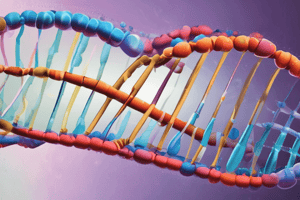Podcast
Questions and Answers
What does the mRNA codon AUG signify in the translation process?
What does the mRNA codon AUG signify in the translation process?
- It codes for Glycine.
- It codes for Valine.
- It codes for Serine.
- It codes for Methionine. (correct)
In the transcription process, which sequence correctly represents mRNA synthesized from the given DNA template?
In the transcription process, which sequence correctly represents mRNA synthesized from the given DNA template?
- CAAAAUGGUAGGGUGUUAAAU (correct)
- ATACGCCGCAACTCCGTAGGC
- UAUGCGGCGUUGAGGCAUCCG (correct)
- GTTTTTACCATCCCACTAAU
Which of the following amino acids is NOT found in the protein translated from the first example's mRNA?
Which of the following amino acids is NOT found in the protein translated from the first example's mRNA?
- Methionine
- Valine
- Tryptophan (correct)
- Cysteine
Which statement best describes the role of codons during the translation process?
Which statement best describes the role of codons during the translation process?
What is the function of the RNA polymerase during transcription?
What is the function of the RNA polymerase during transcription?
What is the primary role of helicase during DNA replication?
What is the primary role of helicase during DNA replication?
What enzyme is responsible for adding the RNA primer to the DNA template strand?
What enzyme is responsible for adding the RNA primer to the DNA template strand?
Which of the following enzymes replaces the RNA primer with DNA nucleotides?
Which of the following enzymes replaces the RNA primer with DNA nucleotides?
Which enzyme is responsible for joining pieces of polynucleotide together during DNA replication?
Which enzyme is responsible for joining pieces of polynucleotide together during DNA replication?
During which step of DNA replication does proofreading occur?
During which step of DNA replication does proofreading occur?
What is the purpose of binding proteins during DNA replication?
What is the purpose of binding proteins during DNA replication?
What happens at the replication fork during DNA replication?
What happens at the replication fork during DNA replication?
What process occurs after the transcription of DNA in the central dogma of molecular biology?
What process occurs after the transcription of DNA in the central dogma of molecular biology?
What is the primary function of messenger RNA (mRNA)?
What is the primary function of messenger RNA (mRNA)?
Where does transcription take place?
Where does transcription take place?
What role does transfer RNA (tRNA) play in protein synthesis?
What role does transfer RNA (tRNA) play in protein synthesis?
What occurs during the elongation phase of transcription?
What occurs during the elongation phase of transcription?
Which type of RNA is primarily responsible for forming the structure of ribosomes?
Which type of RNA is primarily responsible for forming the structure of ribosomes?
What is the purpose of the termination stage in transcription?
What is the purpose of the termination stage in transcription?
During translation, how is the amino acid added to the protein chain?
During translation, how is the amino acid added to the protein chain?
Which codon corresponds with the anticodon UAC found in tRNA?
Which codon corresponds with the anticodon UAC found in tRNA?
Flashcards are hidden until you start studying
Study Notes
DNA Replication
- The process by which a DNA molecule is copied to produce two identical DNA molecules
- Occurs in the nucleus
- Necessary for cell division, ensures each daughter cell receives a complete copy of genetic information
DNA Replication: Steps
- Unwinding DNA:
- Helicase enzyme unwinds and separates the DNA strands
- Binding proteins stabilize the separated strands
- DNA gyrase prevents tangling of the DNA strands
- Primer Binding:
- Primase enzyme adds a short RNA primer to the 3' end of the DNA template
- Polymerization/Elongation:
- DNA polymerase III copies each strand, adding complementary bases
- DNA polymerase I replaces the RNA primer with DNA nucleotides
- DNA ligase joins the newly synthesized DNA fragments
DNA Repair
- Proofreading: DNA polymerases have a proofreading function to correct errors during replication
- Mismatch Repair: Specific proteins identify and correct mismatched base pairs after replication
Transcription
- The first step in protein synthesis, where DNA is used as a template to create RNA
- Occurs in the nucleus
Transcription: Steps
- Initiation: RNA polymerase binds to the promoter region of a gene, unwinding the DNA
- Elongation: RNA polymerase reads the DNA strand and builds the mRNA molecule, adding complementary bases
- Termination: Transcription ends when RNA polymerase reaches a termination sequence, releasing the complete mRNA molecule
Translation
- The second step in protein synthesis, where mRNA is translated into a protein
- Occurs in the ribosomes
Translation: Steps
- Ribosome Binding: The mRNA molecule binds to the ribosome
- Codon Recognition: Each codon on the mRNA is recognized by a specific tRNA molecule carrying the corresponding amino acid.
- Peptide Bond Formation: Amino acids are linked together by peptide bonds, forming a polypeptide chain
- Termination: The polypeptide chain is released when the ribosome encounters a stop codon
Central Dogma of Molecular Biology
- Explains the flow of genetic information from DNA to RNA to protein
- Transcription: DNA to RNA
- Translation: RNA to protein
Types of RNA
- Messenger RNA (mRNA): Carries genetic information from DNA to ribosomes, specifying the amino acid sequence for protein synthesis.
- Ribosomal RNA (rRNA): A major component of ribosomes, essential for protein synthesis.
- Transfer RNA (tRNA): Carries specific amino acids to the ribosome, matching them to their corresponding codons on the mRNA.
Studying That Suits You
Use AI to generate personalized quizzes and flashcards to suit your learning preferences.




